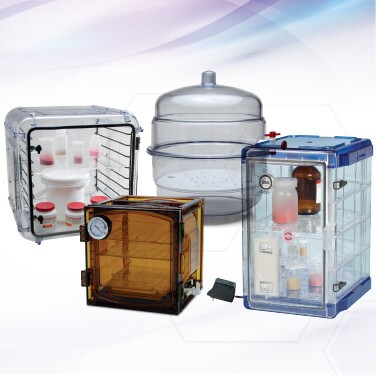How to Choose the Right Desiccator
Desiccators are an economical and reliable way to maintain dry, dust-free storage and organization of reagents or electronics that are sensitive to humidity. Proper storage conditions can be optimized by selecting the desiccator size, shape, and control mechanism best suited to your application, space requirements, and the items that you store.
But how do you know which desiccator is right for your work? Kathleen Hanek, Portfolio Management Leader for Bel-Art – SP Scienceware Secador, Space Saver, Techni-Dome, Dry-Keeper, and Lab Companion brand desiccators, offers her thoughts:
Q: With so many desiccators to choose from, how do I narrow down my options?
A: First, decide which of the four basic methods of desiccation best suits your needs. Each method has its unique advantages and trade-offs.
- Standard desiccators typically use cartridges and are economical, but they require monitoring and occasional cartridge changes to maintain a continuous dry environment.
- Automatic desiccators regenerate the desiccant as needed and require minimal monitoring, but are generally more expensive than standard desiccators.
- Vacuum desiccators remove air and moisture using an in-house system or vacuum pump; the vacuum can easily be restored after opening and they can be used for degassing.
- Gas purge desiccators achieve ultra-dry environments using argon, nitrogen, or other gases, but require special equipment and a source for the gases.
Q: How do style and size affect my choice of desiccator?
A: Both round and cabinet-style desiccators range in size from quite small to very large. Determine the sizes of the items and the quantities that you need to store. Also consider where the desiccator will be placed, its interior volume, and shelving options.
- Round desiccators typically have a single shelf and a domed top for extra vertical space, and they’re less likely to implode.
- Cabinet desiccators are easy to access, have more storage capacity, may be stackable to save space, and often have multiple adjustable shelves.
- Vacuum desiccators were traditionally available only in a round shape because the square shape could implode under vacuum.
- Lab Companion desiccators are designed to withstand a vacuum and combine the benefits of vacuum desiccation with a larger capacity, easier access, and reduced space requirements.
Q: What are the benefits of upgrading to a newer desiccator model?
A: Newer desiccators may include digital hygrometers, the ability to hold a vacuum longer, and better gaskets and seals for an airtight environment without the need for vacuum grease. Plastic desiccators offer the same strength as glass, but at a fraction of the cost and weight.

Content provided by:
Learn more about smart Bel-Art dessicator choices.
Read More from Lab Reporter Issue 2, 2019
- Adaptive Fabric Responds to Changes in Body Temperature
- Brain Metabolism Study Reveals Age Differences Between Sexes
- Chemical Accelerators: The Glove-Related Allergen of the 21st Century
- Ductless Fume Hood Safety
- How to Choose the Right Desiccator
- How to Guard Against Cleanroom Contamination
- Microplastics: Investigating Risk and Understanding Evidence
- Protecting n-Butyllithium from Air and Moisture
- Reduce Strain with Ergonomically Certified Gloves
- Safety Compliance: A Team Effort at Texas A&M
- Save Incubator Space with Round Multilayer Devices
- Second HIV Patient in Remission After Stem Cell Transplant
- Solvent Exposure Can Lead to Hearing Loss
- TCI: Innovating to Improve Lab Safety
